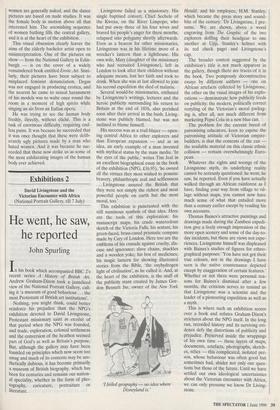Exhibitions 2
David Livingstone and the Victorian Encounter with Africa (National Portrait Gallery, till 7 July)
He went, he saw, he reported
John Spurling
In his book which accompanied BBC 2's recent series A History of British Art, Andrew Graham-Dixon took a jaundiced view of the National Portrait Gallery, call- ing it 'a museum of good behaviour. ... the most Protestant of British art institutions'.
Nothing, you might think, could better reinforce his prejudice than the NPG's exhibition devoted to David Livingstone, Protestant missionary saint in excelsis of that period when the NPG was founded, and trade, exploration, colonial settlement and the conversion of the heathen seemed part of God's as well as Britain's purpose. But, although the gallery may have been founded on principles which now seem too smug and much of its contents may be aes- thetically dubious, it has become primarily a museum of British biography, which has been for centuries and remains our nation- al speciality, whether in the form of pho- tography, caricature, portraiture or literature. Livingstone failed as a missionary. His single baptised convert, Chief Sechele of the Kwena, on the River Limpopo, who had put away three of his four wives and braved his people's anger for three months, relapsed into polygamy shortly afterwards. Even as a beacon for other missionaries, Livingstone was in his lifetime more of a wrecker's lantern than a lighthouse. His own wife, Mary (daughter of the missionary who had recruited Livingstone), left in London to look after their children without adequate means, lost her faith and took to drink. When she was at last allowed to join his second expedition she died of malaria.
Several would-be missionaries, enthused by Livingstone's writings, lectures and the heroic publicity surrounding his return to Britain at the end of 1856, also perished soon after their arrival in the bush. Living- stone was publicly blamed, but was not inclined to blame himself.
His success was as a trail-blazer — open- ing central Africa to other explorers and thus European expansion — and as an idea, an early example of a man invested with mythical status by the mass media. 'In the eyes of the public,' writes Tim Jeal in an excellent biographical essay in the book of the exhibition (NPG, £16.95), 'he owned all the virtues they most wished to possess: bravery, philanthropic zeal and selflessness . .. Livingstone assured the British that they were not simply the richest and most powerful people on earth but the most moral, too.'
This exhibition is punctuated with the still numinous symbols of that idea. Here are the tools of this exploration: his manuscript maps, his crude watercolour sketch of the Victoria Falls, his sextant, his green-faced, brass-cased prismatic compass made by Cary of London. Here too are the emblems of his crusade against cruelty, dis- ease and ignorance: slave chains, shackles and a wooden yoke; his box of medicines; his magic lantern for showing illustrated stories from the Bible, 'the oxyhydrogen light of civilisation', as he called it. And, at the heart of the exhibition, is the stuff of the publicity stunt created by James Gor- don Bennett Jnr, owner of the New York 'I failed geography — no idea where Disneyland is.' Herald, and his employee, H.M. Stanley, which became the press story and sound- bite of the century: 'Dr Livingstone, I pre- sume.' We are shown, above a wood engraving from The Graphic of the two explorers doffing their headgear to one another at Ujiji, Stanley's helmet with its red check pagri and Livingstone's cap.
The broader context suggested by the exhibition's title is not much apparent in the gallery, though there are traces of it in the book. Two pompously deconstructive essays by different authors — one on African artefacts collected by Livingstone, the other on the visual images of his explo- rations — demonstrate how publicity feeds on publicity: the modern, politically correct restyling of the Victorian's moral packag- ing is, after all, not much different from marketing Pepsi Cola in a new blue can.
The problem for the current breed of patronising educators, keen to expose the patronising attitude of Victorian empire- builders, is that the contents of the can — the available material on this classic ethnic collision — remain overwhelmingly Euro- pean.
Whatever the rights and wrongs of the Livingstone myth, its underlying reality cannot be seriously questioned: he went, he saw, he reported. Even if you have actually walked through an African rainforest as I have, finding your way from village to vil- lage without maps, you cannot now have much sense of what that entailed more than a century earlier except by reading his own accounts.
Thomas Baines's attractive paintings and drawings made during the Zambesi expedi- tion give a lively enough impression of the more open scenery and some of the day-to- day incidents, but these are views not expe- riences. Livingstone himself was displeased with Baines's studies of figures for ethno- graphical purposes: 'You have not got their true colours, nor in the drawings I have seen is the native countenance depicted except by exaggeration of certain features.' Whether or not there were personal rea- sons for Baines's dismissal after a few months, the criticism serves to remind us that Livingstone was a scientist and the leader of a pioneering expedition as well as a myth.
This is where such an exhibition scores over a book and refutes Graham-Dixon's strictures about the NPG itself. In the long run, recorded history and its surviving evi- dence defy the distortions of publicity and prejudice. Preserved inside the wrappings of his own time — these layers of maps, documents, artefacts, photographs, sketch- es, relics — this complicated, isolated per- son, whose behaviour was often good but sometimes bad, abides not only our ques- tions but those of the future. Until we have settled our own ideological uncertainties about the Victorian encounter with Africa, we can only presume we know Dr Living- stone.


























































 Previous page
Previous page